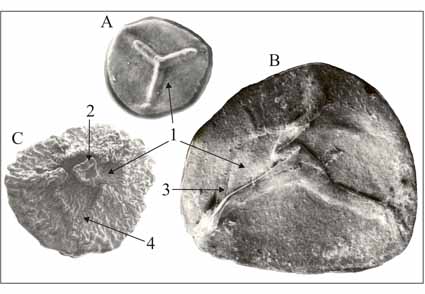Abstract
The paper presents a new genus, Biternatisporites gen. nov., which is represented by a single species, B. compositus comb. nov.. This genus was found in the Middle Carboniferous sediments (Bashkirian age) of the Tunguska Basin, Russia. A description of the sediments where the new genus was found is given. The area of Biternatisporites gen. nov. represents a double ray system: large rays reach the edge of the megaspore, and small rays go beyond the corners of large rays. The new genus belongs to the first ecological and morphological type of megaspores, in terms of evolutionary development. This type is characterized by a simple morphological structure of the shell, consisting of the distal and proximal sides. On the proximal side there is an area bearing a tetrad scar and rare sculptural elements.
References
<p align="justify"><span style="color: #000000;"><span style="font-family: Times New Roman, serif;"><span style="font-size: small;">Dybová-Jachowicz, S., Karczewska, J., Lachkar, G., Loboziak, S., Piérart, P. & Zoldani, Z. (1979) Preliminary note on revision of carboniferous megaspores with gula. Principles of classification. Acta Paleontology Polonica 24 (4): 411–422. [https://app.pan.pl/archive/published/app24/app24-411.pdf]</span></span></span>
<p align="justify"><span style="color: #000000;"><span style="font-family: Times New Roman, serif;"><span style="font-size: small;">Geinz, H.B. (1862) Dyas oder Zechsteinformation und das Rothliegende. Verlag von Wilhelm Engelmann, Leipzig, 342 pp. https://doi.org/10.5962/bhl.title.44568</span></span></span>
<p align="justify"><span style="color: #000000;"><span style="font-family: Times New Roman, serif;"><span style="font-size: small;">Ibrahim, A.C. (1933) Sporenformen des Aegirhirizonts dea Puhr-Reviers. Dissertationsdruckerei K. Triltsch, Würzburg, 48 pp.</span></span></span>
<p align="justify"><span style="color: #000000;"><span style="font-family: Times New Roman, serif;"><span style="font-size: small;">Luber, A.A. (1938) Spores and pollen from coals of Permian deposits of the USSR. Problems of Soviet Geology 8 (2): 152–160. [in Russian]</span></span></span>
<p align="justify"><span style="color: #000000;"><span style="font-family: Times New Roman, serif;"><span style="font-size: small;">Mashchuk, I.M. (1991) Kompleksy megaspor i ih stratigraficheskoe znachenie dlya raschleneniya pozdnepaleozojskoj tolshchi Tungusskogo bassejna (Complexes of megaspores and their stratigraphic value for partition of Late Paleozoic rock mass of the Tunguska basin). In: Budnikov, I.V. (ed.) Stratigrafiya i litofacial’nyj analiz verhnego paleozoya Sibiri. Nauka, Novosibirsk, pp. 123–128. [in Russian]</span></span></span>
<p align="justify"><span style="color: #000000;"><span style="font-family: Times New Roman, serif;"><span style="font-size: small;">Mashchuk, I.M. (2009) Nahodki megaspor v sredne-karbonovyh otlozhenij Tungusskogo bassejna (Findings of megaspores in the Middle Carbon sediments of the Tunguska basin). News of Paleontology and Stratigraphy (Appendix to the journal Russian Geology and Geophysics) 12: 43–51. [in Russian]</span></span></span>
<p align="justify"><span style="color: #000000;"><span style="font-family: Times New Roman, serif;"><span style="font-size: small;">Mashchuk, I.M. (2010) Morfologiya pozdnepaleozojskih megaspor Tungusskogo bassejna (Morphology of Late Paleozoic megaspores of the Tunguska basin). Lethaea rossica. Russian Paleobotanical Journal 2: 55–61. [in Russian; http://www.paleobot.ru/pdf/04_2010_02.pdf]</span></span></span>
<p align="justify"><span style="color: #000000;"><span style="font-family: Times New Roman, serif;"><span style="font-size: small;">Odintsov, M.M. (1957) Osnovnye cherty geologii Sibirskoj almazonosnoj provincii (Main features of the geology of the Siberian diamond province). Proceedings of the Eastern Branch of the USSR Academy of Sciences 1: 90–115. [in Russian]</span></span></span>
<p align="justify"><span style="color: #000000;"><span style="font-family: Times New Roman, serif;"><span style="font-size: small;">Oshurkova, M.V. (1964) Klassifikaciya kamennougol’nyh megaspor (Classification of Carboniferous megaspores). In: Saks, V.N. & Chlonova, A.F. (eds.) Sistematika i metody izucheniya iskopaemyh pyl’cy i spor. Nauka, Moscow, pp. 61–74. [in Russian]</span></span></span>
<p align="justify"><span style="color: #000000;"><span style="font-family: Times New Roman, serif;"><span style="font-size: small;">Oshurkova, M.V. (2001) Megaspory karbona. Sistematika, biostratigraficheskoe znachenie. Spravochnik dlya paleontologov i geologov. (Carboniferous Megaspores. Systematics, biostratigraphic value. Reference book for paleontologists and geologists). VSEGEI publishing house, St. Peterburg, 112 pp. [in Russian; https://rusist.info/book/248179]</span></span></span>
<p align="justify"><span style="color: #000000;"><span style="font-family: Times New Roman, serif;"><span style="font-size: small;">Pant, D.D. (1954) Suggestions for the classification and nomenclature of fossils spores and pollens grains. Botanical Review 20 (1): 33–60. https://doi.org/10.1007/BF02872366</span></span></span>
<p align="justify"><span style="color: #000000;"><span style="font-family: Times New Roman, serif;"><span style="font-size: small;">Potonie, R.H.H.E. & Kremp, G.O.W. (1954a) Die Gattungen der palaozoischen Sporae disperse und ihre Stratigraphie. Geologisches Jahrbuch 69: 111–194.</span></span></span>
<p align="justify"><span style="color: #000000;"><span style="font-family: Times New Roman, serif;"><span style="font-size: small;">Potonie, R.H.H.E. & Klaus, W. (1954b) Einige Sporengattungen des alpinen Salzgebirges. Geologisches Jahrbuch 68: 517–546. [https://disk.yandex.com/i/n4Ci7fcUhgU3d]</span></span></span>
<p align="justify"><span style="color: #000000;"><span style="font-family: Times New Roman, serif;"><span style="font-size: small;">Reinsch, P.F. (1881) Neue Untersuchungen über die Mikrostruktur der Steinkohle des Carbon, der Dyas und Trias. Verlag von T.O. Weigel, Leipzig, pp. 322. [https://archive.org/details/neueuntersuchun00reingoog]</span></span></span>
<p align="justify"><span style="color: #000000;"><span style="font-family: Times New Roman, serif;"><span style="font-size: small;">Zerndt, J. (1930) Megasporen aus einem Floz in Libias (Stephanien). Bulletin International Academie. Cracovie Ser. B (1): 39–70.</span></span></span>


